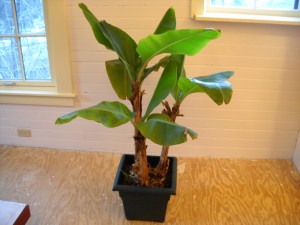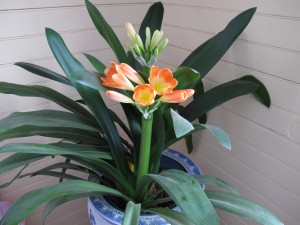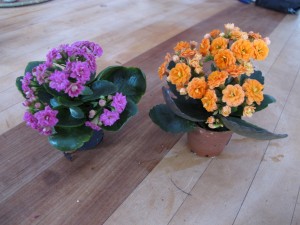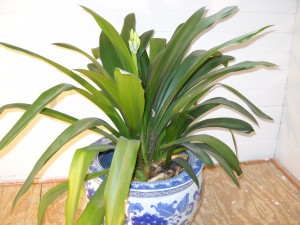House Plants That Are Really, Really Easy
I recently went over to a houseplant and gave it praise. I said, “Thank you clivia, for producing flowers for me. I know I don’t deserve them because I don’t do anything for you. I don’t even wipe the dust off your beautiful green leaves. You are so undemanding that sometimes I’ve gone a whole month without watering you – and didn’t wilt or complain. And now you are beginning to flower. Thank you.” I really did say that. And I meant it.
Clivia, also known as Kaffir lily, is a plant that comes from South Africa where it lives in deep forests with low light conditions and survives much of the year without rain. So it is an ideal houseplant. It has18-24-inch glossy strap-like leaves and once a year it produces a tall flower stalk with a cluster of orange blossoms. I haven’t done anything for mine, and it has produced two more plants, offsets from the parent plant. And now one of those two offsets is preparing to bloom, too.
But bloom time is unpredictable for my clivia. Keeping it quite dry in the winter in a cold room and then giving it a little liquid fertilizer now is supposed to help it wake up and bloom. I’ve never given mine fertilizer, and still it blooms. One year it bloomed in August and won a blue ribbon at the Cornish Fair.
I like keeping an aloe plant in the house to use occasionally on a burn or a bothersome bug bite. You have bought hand lotion with aloe vera in it, I’m sure. The aloe plants available for purchase have similar healing properties – just cut off a leaf and rub the cut surface on a burn, spreading its juices. Again, I do nothing for it. It sits in a north window, getting little or no direct sunlight. And it only gets watered very occasionally. Yet it has survived for 25 years or so. Benign neglect.
At the Vermont Flower Show I bought some perky little plants that I’ve had before: kalanchoe. Think energizer bunny. They are commonly sold in grocery in 2-inch pots, loaded with little pink or yellow or orange blossoms. And they just keep on blooming, for months, it seems. I keep mine on a morning-sun windowsill, and do actually give them water once a week. If I forget to water they droop, but quickly recover with a good soaking. I only paid $3.99each and they keep blooming. What’s not to like?
Then there is the pony tail palm (Beaucarnea recurvata). This is a houseplant that reminds me of a soccer ball in a pot, topped with a woody stem and a big head of green strap-like leaves thrown off in all directions. I keep mine in a 12-inch deep pot and still the leaves are so long they hang down to the table.
In the summer I leave my ponytail palm on the deck where it gets a few hours of sunshine each day. In the winter I keep it in a west-facing window and only water once a month or so – the bulbous base stores water, and it goes somewhat dormant in winter anyhow.
Swedish ivy (Plectranthus sp.) is another “you can’t kill me” plant. It is not an ivy, but does make long stems that will hang down and out of a pot. The leaves of mine are all green with purplish stems. Occasionally it will produce tiny light blue flowers.
The great thing about Swedish ivy is that it is so easy to start new plants. Just cut off a few stems, put in a jar of water, and they will root. Then pot a group of them up for a nice pot of foliage. It does like more water than the other plants discussed above, but it always recovers if I let it dehydrate. It can appear dead, but so far, mine has always bounced back.
The last of my favorite tough-as-a nail house plants is crown of thorns (Euphorbia milii). I have one that is at least a hundred years old, so you know that it has had some rough treatment in its day. I don’t like the thorns, but I do like that it produces dozens of nice small bright red flowers all winter in a west-facing window. Like the others, it never seems to complain when I ignore it.
The worst thing you can do for most houseplants is to water too often. Most reliable, rock-solid houseplants come from the tropics, often from South Africa. Most can go a month or more without water – it’s what they have to survive in the wild.
I don’t fertilize houseplants. In nature no one comes along with liquid fish juice or a chemical solution to “help” them. Fertilizer will push growth – but I don’t need bigger house plants. I need easy houseplants – and probably a few less than I have. Re-potting helps many houseplants, but those I mentioned above I have never re-potted, either. Crown of thorns is too prickly. I’ve read that clivia roots are almost impossible to pull apart. So I just say thanks to my plants, or offer them a few words of encouragement, and they do just fine.
Henry’s newest book, Wobar and the Quest for the Magic Calumet is a children’s chapter book about a boy born with a magical mustache and the ability to speak to animals. Learn more at www.henryhomeyer.com. Reach Henry at henry.homeyer@comcast.net.
Easy Houseplants to Brighten Your Winter
Before we launch into this week’s article…
Gardening Classes with Henry
Lebanon College: Gardening: A Practical Workshop. Garden writer Henry Homeyer will teach you the basics of organic vegetable and flower gardening. From garden design to seed-starting , planting, watering, weeding, mulching, and harvesting, this course will give each student practical knowledge of gardening. Tuesday nights from 6:30-8:30 for 5 weeks, April 3-May 2.Contact Lebanon College to reserve a spot for this5-part workshop www.lebanoncollege.edu or call 603-448-2445.
AVA Gallery, Lebanon. Henry will teach 3 classes at AVA Gallery this spring. You may sign up for one or all of these workshops:
Sculpting the Living Landscape: Starting Flowers from Seed
April 9; Monday, 6:30–8:30pm; One 2-hour class
Sculpting the Living Landscape: Perfect Perennials for the Upper Valley Garden
April 23; Monday, 6:30–8:30pm; One 2-hour class
Sculpting the Living Landscape: Organic Techniques for Enriching Soil and Managing Pests
May 7; Monday, 6:30–8:30pm; One 2-hour class
For more information go to www.avagallery.org or call 603-448-3117.
Easy Houseplants to Brighten Your Winter
Many a would-be gardener has been deterred from growing veggies or flowers outdoors because they’ve had a bad time with houseplants. “Garden? Not me! I’ve got a brown thumb.” If I’ve heard it once, I’ve heard it dozens of times. When I inquire, people tell me they’ve killed houseplants, even the so-called “bullet proof” ones.
More houseplants are killed by over-watering than by under-watering. Some inexperienced gardeners think they are being kind and attentive to their plants by watering often. But roots of most houseplants will rot if kept constantly wet. So my first rule of indoors plants is simple: only water a plant when the soil is dry to the touch. For most, that is no more than once a week. For some once every 3-4 weeks is adequate.
Some houseplants are grown for their blossoms and others for their lovely foliage. Foliage plants are generally the easiest: if it isn’t dead, it probably looks good.
Jade plant (Crassula ovate or C. argentea) is an easy plant that is almost trouble-free. It has thick, waxy succulent leaves that are round and shiny. The trunk is thick in mature plants, and is a smooth gray or brown. My friend Cindy Heath has one, and it languishes in her living room getting no care at all. I mean it gets little direct sunshine and if it gets a drink of water every couple of months, it’s lucky. Last summer I carried it outside on the porch for some sunshine, which prompted a growth spurt.
Jade plants are easy to propagate. Bernice Johnson of Cornish Flat, NH, showed me a jade plant that she started from a cutting 3 years ago that is now about 2 feet tall and 2 feet across. She said that to get a new plant she just snips off a short section of a branch with a leaf or two, and plants it, or sets it in water to root, then plants it. She plants her many houseplants in a mix of garden soil and compost she makes herself from leaves and garden waste. The soil drains well, which is important. She keeps the plant near a north window and waters it about once a month. I find a 50-50 mix of compost and potting soil is good for most houseplants.
Happy Griffiths of Lebanon, NH grows many houseplants, including both rosemary and bay. Those two not only produce handsome foliage, but also edible herbs for use in the kitchen. Both, she told me, like a cool environment with bright natural light. She keeps hers in an unheated sunroom that gets down below freezing on cold nights, but never very cold. Some forms of rosemary bloom annually, though other types do not.
If you grow rosemary indoors, you need to increase the water you give it starting in March, or even by mid- February. The sun is stronger, the days are longer, and the roots and leaves are beginning to grow. Even though it is a Mediterranean plant, if it gets totally dried out – as mine have in the past – the plant dies. Instead of once a week, water twice a week.
I grow clivia (Clivia spp.) as a foliage plant – it has long, shiny strap-shaped leaves and requires virtually no care. I’ve had mine for more than 10 years and have never divided it nor fertilized it. Even so, once a year it sends up a flower spike with a big cluster of orange blossoms that last for a couple of weeks. I water it very irregularly –once a month, if I think of it. It doesn’t need direct light, which is nice as I have it in a pot too big for the window sill. Its leaves stand about 30 inches tall.
Another nice foliage plant is aloe (Aloe vera)). It is a succulent that needs little watering, rarely has pests, and survives wherever you plunk it. A nice benefit is that if you cut a leaf and rub the juice on a burn or insect bite it will soothe your skin.
Bernice Johnson grows lots of old fashioned geraniums (Pelargonium spp.) that she keeps on sunny window sills. When I visited her recently she had one in full bloom in her warm kitchen that also has a wood stove. Wood stoves generally are hard on houseplants – they make rooms too hot and too dry for most. But her geraniums thrive – in part because she waters them regularly. In the spring she will cut back the long stems and put them outside, pots and all, for the summer.
I recommend that everyone have a few houseplants. I have too many (including a large banana plant, a hibiscus tree, a nice clump of papyrus and many more). Plants make the interior air more humid, and some take out pollutants. And best of all, they keep my hand in gardening activities all winter long.
Visit Henry’s Web site, www.Gardening-guy.com for more information and photos of houseplants. His e-mail is henry.homeyer@comcast.net
Web Extras: Other House Plants I Grow
 Another great foliage plant I grow is a banana “tree”. They don’t get woody, even in the tropics, but can get tall – even in the house. I got a small one 5 years ago and have been growing it in a large pot since then. In the summer it is outside, and in the winter I keep it in a west-facing window. Well, not in the window,but on the floor near the window. The banana has yet to produce fruit, but it has made 3 or 4 shoots that I intend to separate next summer and put in individual pots. My banana is now 4 feet tall, and has never had aphids or other pests.
Another great foliage plant I grow is a banana “tree”. They don’t get woody, even in the tropics, but can get tall – even in the house. I got a small one 5 years ago and have been growing it in a large pot since then. In the summer it is outside, and in the winter I keep it in a west-facing window. Well, not in the window,but on the floor near the window. The banana has yet to produce fruit, but it has made 3 or 4 shoots that I intend to separate next summer and put in individual pots. My banana is now 4 feet tall, and has never had aphids or other pests.
The exception to the rule, “Don’t overwater” is the papyrus. It needs to grow in a constantly wet location. I planted a small one a few years ago in a nice Chinese vase that has no hole. I water until the water is saturated and standing water is above the soil line. I grow mine in an east-facing window. The stems get to be 3-feet tall, with nice lacy fronds.
Pineapple plants, decorative ones, are also on the market this year. I got one at a florist shop and it is very nice. It has a miniature pineapple on a stem above the foliage, but it will never get big – or edible.






